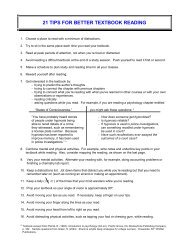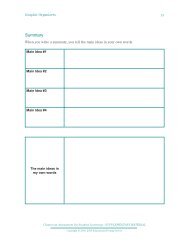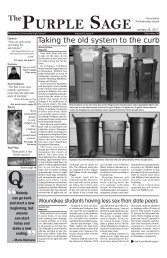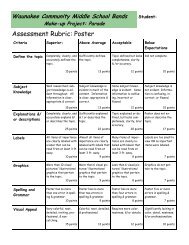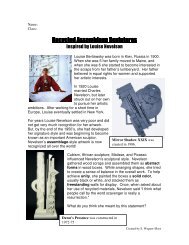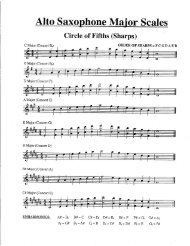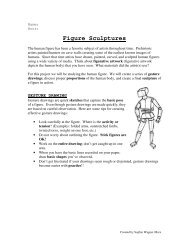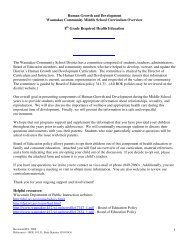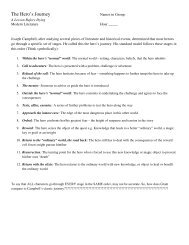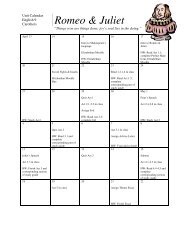Repousse Masks
Repousse Masks
Repousse Masks
Create successful ePaper yourself
Turn your PDF publications into a flip-book with our unique Google optimized e-Paper software.
Name:<br />
Hour:<br />
<strong>Repousse</strong> is a French word that means to push down or indent. For this project you will<br />
be creating a metal mask using repousse to create interesting patterns and textures on<br />
the surface of the mask. <strong>Repousse</strong> is a way to create dynamic low relief sculpture.<br />
You will be creating a mask that represents very ancient traditions in several parts of the<br />
world. First we will look at the purpose and function of masks in African culture. Then<br />
we will examine Carnival masks of New Orleans and Venice, Italy.<br />
Your first job will be to think about and discuss the significance<br />
of masks. Please complete a Type 1 Collins writing on what you<br />
know about masks. Consider the following questions.<br />
• Why do people wear masks?<br />
• Who wears masks?<br />
• When do people wear masks?<br />
• What are masks made of?<br />
• Where do people wear masks?<br />
It is easy to enjoy and appreciate the bold designs<br />
and powerful visual impact of African masks.<br />
Picasso and other Cubists were very influenced by<br />
the simple, abstract features and strong patterns<br />
they saw in African masks. In addition to<br />
appreciating their artistic value, it is also important<br />
to understand the significance of African masks in<br />
African culture and customs.<br />
In Africa, masks are functional (or useful) art that are full of symbolism.<br />
<strong>Masks</strong> are part of religious, social, and funerary ceremonies, and often<br />
represent the spirits of their ancestors. When brought to life through<br />
movement and music, dancers are transformed by the power of the spirits<br />
held in the masks they wear. The spirit takes over and becomes part of the<br />
ritual.<br />
Created by Sophie Wagner-Marx
It is interesting to note that traditionally masks are created and worn exclusively by men.<br />
While masks can be female in design, only male dancers wear the masks and are<br />
controlled by the masks spirit. Female artists in traditional African society specialize in<br />
functional 2-D arts like textiles and decorative house painting.<br />
Traditional African masks can be made from a number of<br />
materials including bronze, brass, copper, ivory, leather, clay,<br />
or textiles. Wood, however, is the most common material<br />
chosen for the creation of a mask. One reason for this is that it<br />
is believed that trees have a soul, so masks carved from trees<br />
will also have a soul.<br />
In addition to their significance in Africa, masks have played<br />
important roles in other cultures throughout the world. Burial<br />
masks were used in China, Rome, Mexico, and Egypt.<br />
Theater masks were used in China, India, Japan, Greece, and<br />
Rome. And, in various tribes throughout the Americas, ritual<br />
masks are used in ceremonies for fertility, planting,<br />
harvesting, curing illness, and combating witchcraft.<br />
There are a few important things to know about the design of<br />
African masks. The shape, features, and patterns of a mask all<br />
help depict its spirit or personality.<br />
African craftspeople employ a variety of design tactics when<br />
creating a mask. A good place to start is with the overall shape.<br />
The shape of a mask can be oval, heart shaped, animal, human,<br />
circular, rectangular, or any combination of these. African<br />
masks almost always exhibit symmetrical balance.<br />
Symmetry is<br />
___________________________________________________<br />
__________________________________________________.<br />
Features of African masks are very simple and stylized.<br />
Features help describe the spirit of the mask by showing the<br />
audience if the mask represents courage, beauty, humor,<br />
mischief, honesty, etc. Emphasizing features through<br />
exaggeration will also help you portray the spirit of your mask.<br />
Think about enlarging the lips, eyes, or nose for added effect.<br />
(When you decide on the personality your mask will have, look<br />
Created by Sophie Wagner-Marx
at examples of African masks to find features that will illustrate your idea. Again, the<br />
features of African masks are symmetrical.)<br />
The last things you need to consider when designing a mask are the patterns you will<br />
add to create visual impact. When using repousse to add the patterns to your metal<br />
mask, you will also create texture. (There will be templates available that you can use to<br />
create uniform patterns. It would be a good idea to look at these ahead of time to decide<br />
which will work best to emphasize your design.)<br />
Pattern is ____________________________________________________________.<br />
Texture is ____________________________________________________________.<br />
Use these boxes to create two thumbnail sketches of your ideas. After you’ve had your<br />
design checked by Ms. W, you will transfer your sketch to a larger piece of paper and the<br />
metal foil. Do not forget to use symmetry, stylized features, emphasis<br />
and pattern!<br />
<strong>Repousse</strong> Vocabulary<br />
• TOOLING: Creating a 3-Dimensional art form out of a flat sheet of metal.<br />
• STYLUS: A tool used to “draw” designs and patterns on metal. The stylus<br />
allows you to emboss, or indent, the metal.<br />
Created by Sophie Wagner-Marx
• REPOUSSAGE: A French word that refers to the craft of embossing metal from<br />
the back to create a low relief, 3-d sculpture.<br />
• COUNTER REPOUSSE: After first using repousse to indent and emboss a<br />
metal surface, counter repousse is the technique of flipping the metal over and<br />
working on defining the texture further.<br />
Carnival masks have been part of the<br />
Venetian Carnival in Italy, and the<br />
Mardi Gras celebrations in New<br />
Orleans, Louisiana for many years.<br />
People wear the masks as part of a<br />
costume that disguises their identity,<br />
allowing them to participate in acts<br />
they would not normally consider.<br />
• How are carnival masks like African <strong>Masks</strong>?<br />
• How are they different?<br />
The decoration of your <strong>Repousse</strong> Mask can mirror that of the Carnival <strong>Masks</strong>. You may<br />
use bright colors and various adornments to embellish your creation. Consider how the<br />
colors you are choosing work together, and what you will add to create contrast in<br />
textures. (Feathers, beads, pipe cleaners, ribbons, yarn, etc.) Think about how your<br />
embellishments relate back to the emotion or expression of your mask!!<br />
Even though your actual mask is symmetrical, your adornments and embellishments may<br />
be asymmetrical.<br />
Asymmetry is: _______________________________________________.<br />
Created by Sophie Wagner-Marx



